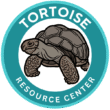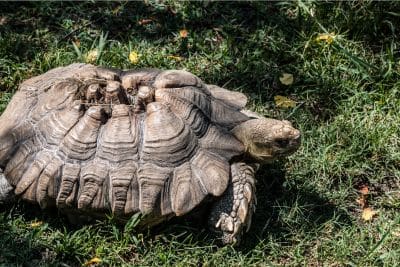Respiratory problems in tortoises are both common and serious. If you’ve noticed your tortoise breathing differently, producing nasal discharge, or acting lethargic, you might be dealing with a tortoise respiratory infection—one of the most frequently diagnosed health issues in captive tortoises.
Here’s what makes respiratory infections particularly dangerous for tortoises: their anatomy works against them. Tortoises don’t have a diaphragm, which means they can’t cough up mucus the way mammals do. That mucus just sits in their lungs and accumulates. They also lack cilia—those tiny hair-like structures that help clear airways in other animals.
The result? Once a respiratory infection takes hold, it can progress quickly from a simple runny nose to life-threatening pneumonia.
If you suspect your tortoise has a respiratory infection, time matters. Early detection and prompt treatment dramatically increase the chances of full recovery. This guide will walk you through exactly what to look for, what you can do at home, when you absolutely need a vet, and how to prevent future infections.
- What Does a Healthy Tortoise Look Like?
- Recognizing Tortoise Respiratory Infection Symptoms
- What Causes Tortoise Respiratory Infection?
- When to Contact a Veterinarian
- Home Treatment for Tortoise Respiratory Infection
- Step 1: Identify and Document Symptoms
- Step 2: Isolate if You Have Multiple Tortoises
- Step 3: Identify the Cause
- Step 4: Optimize Environmental Conditions Immediately
- Step 5: Support Immune Function Through Nutrition
- Step 6: Ensure Proper Hydration
- Step 7: Minimize Stress
- Step 8: Monitor Progress Closely
- Step 9: Follow Veterinary Treatment When Prescribed
- Long-Term Environmental Optimization
- Nutrition and Hydration for Recovery and Prevention
- Preventing Future Tortoise Respiratory Infections
- The Bottom Line on Tortoise Respiratory Infections
- Don't Face Tortoise Health Challenges Alone
What Does a Healthy Tortoise Look Like?
Before you can recognize signs of tortoise respiratory infection, you need to know what normal, healthy breathing looks like.
When a healthy tortoise breathes, there should be minimal body movement with each breath. You shouldn’t see obvious heaving or straining. The nostrils should be clean and dry—no discharge whatsoever. The mouth should be a pale pink color, not gray or blue.
Healthy tortoises are alert and active (for tortoises, anyway). They have good appetite, move around their enclosure regularly, and hold their heads up normally. Keep this baseline in mind so you can quickly spot when something’s off.
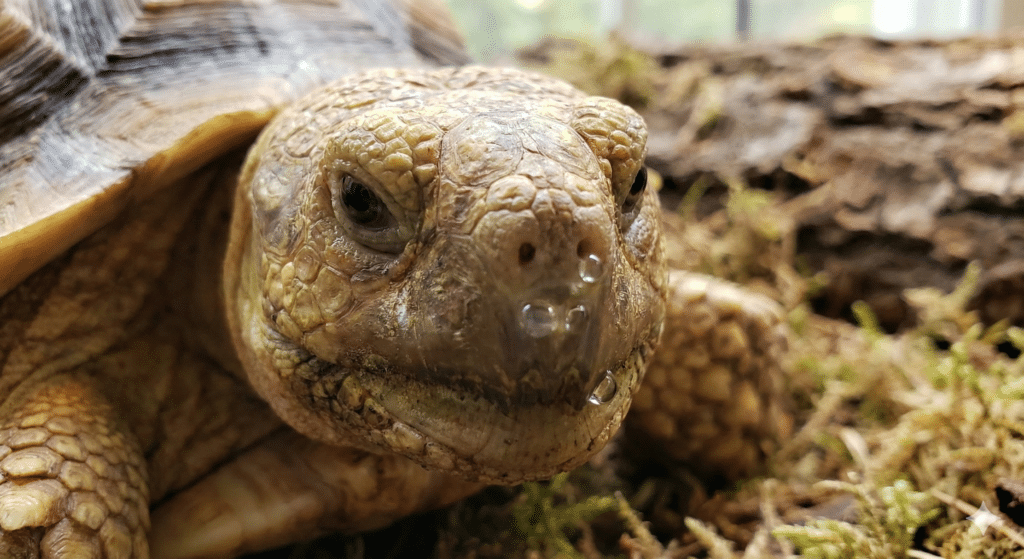
Recognizing Tortoise Respiratory Infection Symptoms
The first sign of a tortoise respiratory infection is usually a runny nose. At this stage, the infection is in the upper respiratory tract. Left untreated, it quickly spreads down into the lungs, where it becomes pneumonia. Once that happens, symptoms become much more severe.
Here’s what to watch for:
Early symptoms:
- Clear nasal discharge (often the very first sign)
- Mild decrease in appetite
- Slightly reduced activity level
Progressive symptoms:
- Nasal discharge that becomes thicker, cloudier, and yellow or green over time
- Open mouth breathing (tortoises should breathe through their noses)
- Whistling, wheezing, or clicking sounds while breathing
- Audible breathing noises you can hear from across the room
Advanced symptoms:
- Obvious difficulty breathing with outstretched head and gulping air
- Drainage or bubbles coming from mouth, nostrils, or eyes
- Resting head on the ground (too weak to hold it up)
- Barely moving around the enclosure
- Pale gray or blue coloration inside the mouth
- Complete loss of appetite
If you’re seeing advanced symptoms, this is an emergency. Don’t wait—get your tortoise to a vet immediately.
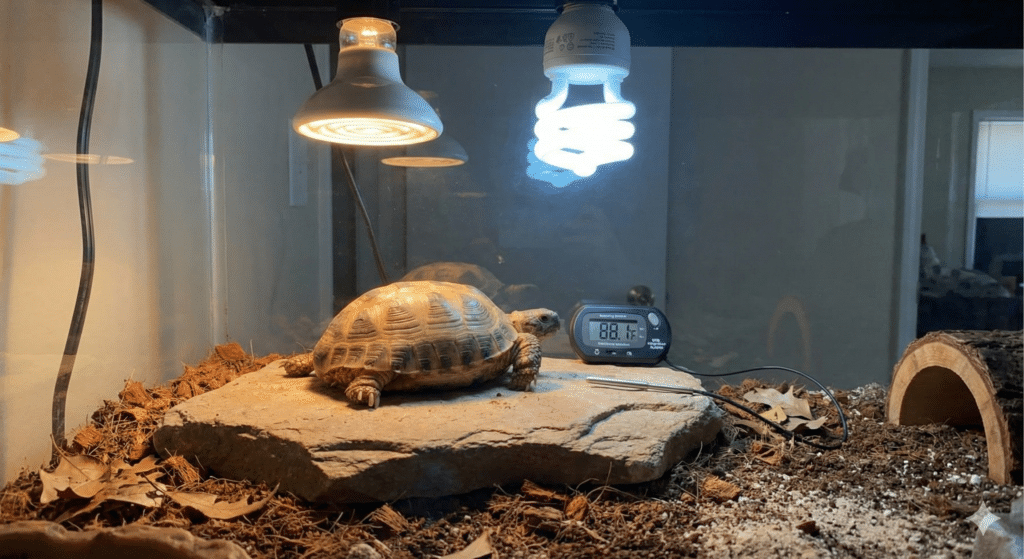
What Causes Tortoise Respiratory Infection?
Understanding causes helps you both treat current infections and prevent future ones.
Bacterial Infections
The most common culprit behind tortoise respiratory infection is a bacterial microbe called Mycoplasma. Interestingly, Mycoplasma occurs naturally in healthy tortoises. It only becomes a problem when your tortoise’s immune system is compromised and can’t keep the bacteria in check.
Other bacterial infections can also cause respiratory problems, especially in tortoises with weakened immune systems.
Timing and Vulnerability
Risk of tortoise respiratory infection is highest right after hibernation. Why? Because a tortoise’s white blood cell count drops dramatically during hibernation, making it much harder to fight off infections.
This is why post-hibernation health checks are so critical.
Secondary Infections
Stomatitis (commonly called “mouth rot”) can develop in immune-suppressed tortoises. Because the mouth, throat, and nasal passages are all connected, mouth infections can easily spread and become respiratory infections.
Are You Starving Your Tortoise?
Save 10% on premium tortoise food and supplements from Tortoise Resource Center on Amazon now using code BUYNOWGET10
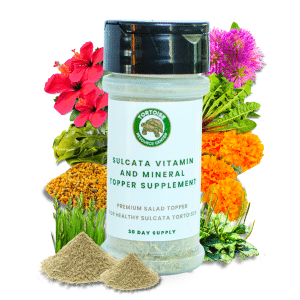
Sulcata Vitamin & Mineral Topper Supplement
30-Day Supply | 2 oz (56 g)
$24.99
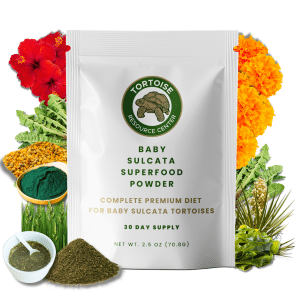
Baby Sulcata Tortoise Superfood Powder
30-Day Supply | 2.5 oz (70.8 g) Bag
$24.99
Poor Husbandry
This is the big one. Most cases of tortoise respiratory infection trace back to inadequate environmental conditions:
Temperature problems: Tortoises kept too cold can’t maintain proper immune function. Their metabolism slows, digestion suffers, and they become vulnerable to infection.
Humidity issues: Both too dry and too humid can cause problems. Overly dry conditions irritate respiratory passages. Excessive humidity combined with poor ventilation creates perfect conditions for bacterial and fungal growth.
Inadequate lighting: Without proper UVB exposure, tortoises can’t synthesize vitamin D3, which affects calcium metabolism and overall immune health.
Dirty conditions: Bacteria thrive in filthy enclosures. Old feces, moldy food, and contaminated water all increase infection risk.
Poor substrate choices: Dusty bedding irritates airways and can trigger respiratory problems even without infection.
Nutritional Deficiencies
Diet plays a huge role in immune function. Inadequate nutrition—whether from lack of variety, overfeeding, underfeeding, or specific vitamin deficiencies—weakens your tortoise’s ability to fight off infections.
Vitamin A deficiency is particularly problematic. This vitamin is essential for maintaining healthy mucous membranes in the respiratory tract. Without adequate vitamin A, those membranes break down and become more susceptible to infection.
Chronic Stress
Just like humans, tortoises under chronic stress have compromised immune systems. Prolonged high cortisol levels suppress immune function, making tortoises more susceptible to pathogens including those that cause respiratory infections.
Stressed tortoises also change their behavior—eating less, basking less, showing more lethargy. These behavioral changes further impact health. For instance, inadequate basking leads to suboptimal body temperatures, which impairs immune function even more.
Common stress causes include:
- Enclosures that are too small
- Lack of hiding spots
- Too much handling
- Loud environments
- Aggressive tank mates
- Frequent enclosure changes
When to Contact a Veterinarian
Let me be very clear about this: tortoise respiratory infection can be fatal if left untreated. While you can provide supportive care at home for mild early symptoms, you need veterinary involvement for proper diagnosis and treatment.
Contact a vet immediately if you see:
- Thick, colored nasal discharge
- Open mouth breathing
- Audible breathing noises
- Lethargy combined with respiratory symptoms
- Loss of appetite lasting more than a day or two
- Any gray or blue coloration in the mouth
You can try home care first if:
- Symptoms are very mild (slight clear discharge only)
- Your tortoise is still eating and active
- You’ve identified and corrected an obvious environmental problem
- You’re monitoring closely and prepared to seek vet care if symptoms don’t improve within 24-48 hours
Even with mild symptoms, I still recommend at least calling your vet for advice. They can help you determine whether home care is appropriate or if you should bring your tortoise in immediately.
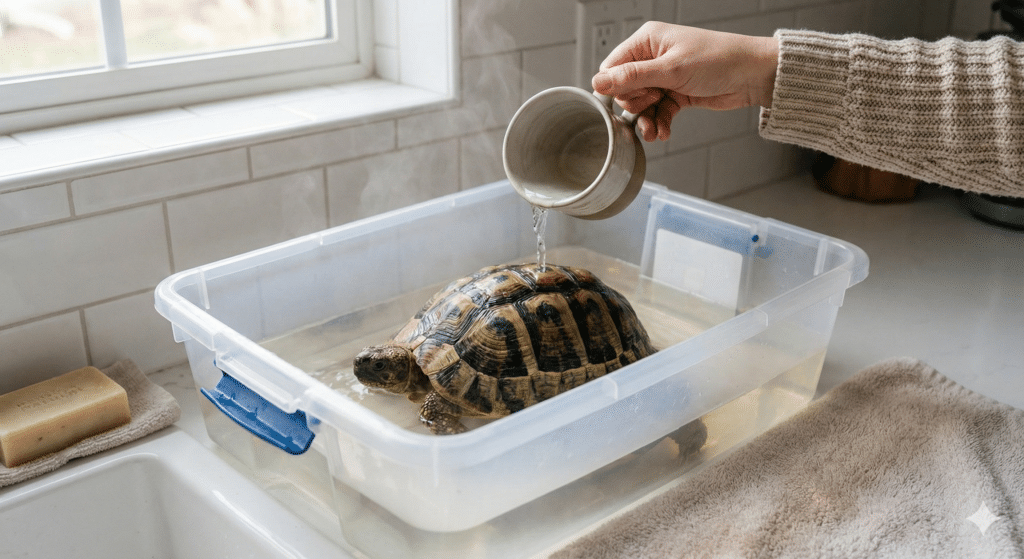
Home Treatment for Tortoise Respiratory Infection
If you’re dealing with very early, mild symptoms and your vet approves home care, here’s your step-by-step approach.
Step 1: Identify and Document Symptoms
Keep detailed notes about what you’re observing:
- When did symptoms start?
- What specific symptoms are present?
- How severe is each symptom?
- Is your tortoise still eating? How much?
- Activity level compared to normal?
Take photos or videos if possible. This documentation helps you track whether your tortoise is improving or getting worse, and it’s valuable information for your vet if you need to escalate care.
Step 2: Isolate if You Have Multiple Tortoises
Tortoise respiratory infection can spread between individuals. If you house multiple tortoises together, separate the sick one immediately.
Keep the isolated tortoise in a clean, appropriately-sized temporary enclosure with proper heating and lighting. Don’t use this as an excuse to downsize their space dramatically—stress from cramped quarters will make things worse.
Step 3: Identify the Cause
Think back over the past few weeks:
- Has the enclosure temperature changed or fluctuated?
- Is your tortoise getting adequate UVB exposure?
- Have you recently changed their diet?
- Did you add new substrate or change bedding?
- Has anything in the environment changed (moved the enclosure, new pets in the house, construction nearby)?
- Did your tortoise recently come out of hibernation?
Understanding what triggered the infection helps you prevent recurrence.
Step 4: Optimize Environmental Conditions Immediately
Fix any husbandry problems you’ve identified. This is the single most important thing you can do.
Temperature: Ensure proper basking area (85-90°F) and cooler zone (75-80°F). Use reliable thermometers to verify—don’t guess. Sick tortoises often benefit from temperatures at the higher end of their species’ range, as this supports immune function.
Humidity: Research your specific species’ needs. Most tortoises do well with 50-70% humidity, but some need more or less. Use a hygrometer to monitor.
Lighting: Provide proper UVB lighting if your tortoise is indoors. Replace UVB bulbs on schedule—they lose effectiveness even when they still produce visible light.
Cleanliness: Do a thorough cleaning of the entire enclosure. Remove all substrate, disinfect surfaces, and replace with fresh, clean substrate.
Step 5: Support Immune Function Through Nutrition
A tortoise fighting respiratory infection needs optimal nutrition to support recovery.
Offer a variety of appropriate foods: leafy greens, grasses, hay, and suitable vegetables based on your species. Avoid fruit during illness—the sugar can actually suppress immune function.
Quality supplementation becomes especially important during illness. The Vitamin and Mineral Topper provides balanced vitamins and minerals including vitamin A, which is crucial for maintaining healthy respiratory tract membranes.
For younger tortoises or those that may have been nutritionally deficient, the Baby Sulcata Superfood Powder offers comprehensive nutrition that supports immune system function during recovery.
Step 6: Ensure Proper Hydration
Dehydration makes everything worse. Make sure your tortoise always has access to clean, fresh water.
Give warm soaks daily during illness—15 to 20 minutes in shallow lukewarm water. Soaking helps keep respiratory passages moist, supports hydration, and can help your tortoise pass waste (important since sick tortoises often become constipated).
Change the water if your tortoise defecates during soaking. You don’t want them absorbing bacteria from contaminated water.
Step 7: Minimize Stress
Reduce handling to absolute necessities only. Keep the environment quiet and stable. Make sure your tortoise has adequate hiding spots where they can feel secure.
Resist the urge to constantly check on them—I know it’s hard when you’re worried, but excessive disturbance adds stress.
Step 8: Monitor Progress Closely
Check on your tortoise at regular intervals (every few hours during the day). Note any changes in symptoms, appetite, or behavior.
Symptoms should start improving within 24-48 hours if home care is working. If you don’t see improvement—or if symptoms worsen at all—contact your vet immediately.
Step 9: Follow Veterinary Treatment When Prescribed
If your vet prescribes antibiotics, nasal drops, or other medications, follow their instructions exactly. Don’t skip doses. Don’t stop treatment early even if your tortoise seems better—completing the full course prevents antibiotic resistance and ensures the infection is fully cleared.
Keep all follow-up appointments. Your vet may want to recheck your tortoise to confirm the infection has resolved.
Long-Term Environmental Optimization
Since poor environmental conditions are the primary cause of tortoise respiratory infection, creating an optimal habitat is essential for both recovery and prevention.
Temperature Management
Tortoises are ectothermic (cold-blooded), meaning they rely entirely on external temperatures to regulate body functions.
Your enclosure must provide a temperature gradient:
- Basking area: 85-90°F
- Cool area: 75-80°F
- Nighttime: Can drop slightly but avoid sudden fluctuations
Use multiple thermometers to monitor temperatures in different zones. Position them at tortoise level, not up near the heat lamp where readings will be artificially high.
Invest in a thermostat for your heating equipment. This prevents dangerous temperature spikes and provides consistent conditions.
Humidity Control
Most tortoises do well with 50-70% humidity, but specific requirements vary by species. Desert species need the lower end of this range, while species from more humid environments need higher levels.
Use a hygrometer to monitor humidity. If levels are too low, mist the enclosure, add a larger water dish, or adjust substrate to retain more moisture. If levels are too high, improve ventilation.
Lighting Setup
Proper lighting includes both:
UVB lighting: Essential for vitamin D3 synthesis, which affects calcium metabolism and immune function. Replace UVB bulbs every 6-12 months depending on manufacturer recommendations.
Heat lighting: Provides basking temperatures. Can be combined with UVB in some bulb types or kept separate.
Position lights at appropriate distances as specified by the manufacturer. Too close can cause burns; too far reduces effectiveness.
Enclosure Cleanliness
Bacteria thrive in dirty conditions, dramatically increasing tortoise respiratory infection risk.
Daily spot cleaning: Remove feces, uneaten food, and soiled substrate every day. Refill water dish with fresh, clean water.
Deep cleaning: Every 4-8 weeks (more often if needed), do a complete enclosure overhaul. Remove all substrate, disinfect all surfaces with reptile-safe cleaner or diluted bleach solution (rinse thoroughly), and replace substrate completely.
Stress Reduction
A stress-free environment supports immune function and prevents illness.
Adequate space: Follow species-specific minimum enclosure size recommendations and go bigger if possible.
Hiding spots: Provide multiple hides so your tortoise can retreat when feeling vulnerable.
Quiet location: Place the enclosure away from high-traffic areas, loud noises, and vibrations.
Stable routine: Maintain consistent feeding times, lighting schedules, and care routines.
Minimal handling: Handle only when necessary for health checks or enclosure maintenance.
Nutrition and Hydration for Recovery and Prevention
Diet plays a massive role in immune function and recovery from tortoise respiratory infection.
Balanced Diet Basics
Tortoises are herbivores who thrive on variety. The bulk of their diet should include:
- Fresh grasses and hay
- Dark leafy greens (dandelion, collard, turnip greens)
- Edible weeds from your yard (if pesticide-free)
- Appropriate vegetables in moderation
Feed fruit very rarely if at all—tortoises have low tolerance for processing sugar, and excessive fruit can actually suppress immune function.
Absolutely avoid processed foods, meat, and high-protein items. These are difficult for tortoises to digest and can cause health problems.
Critical Vitamins and Minerals
Several nutrients are particularly important for respiratory health and immune function:
Calcium: Essential for overall health, bone strength, and shell development. Dust food with calcium powder regularly.
Vitamin D3: Needed for calcium absorption. Synthesized through UVB exposure but may need supplementation for indoor tortoises.
Vitamin A: Critical for immune function and maintaining healthy mucous membranes in the respiratory tract. Deficiency directly increases respiratory infection risk.
Omega-3 fatty acids: Support immune system function.
Even with good base diet, supplementation fills nutritional gaps that are hard to meet through food alone.
Hydration Is Non-Negotiable
Adequate hydration is crucial for respiratory health. Dehydration thickens mucus, making it harder for tortoises to manage respiratory secretions even with their limited abilities.
Always provide access to clean drinking water. Many tortoises also drink during soaking, which provides additional hydration.
Soak your tortoise 2-3 times weekly under normal circumstances. Increase to daily soaking during illness, after hibernation, or in very dry conditions.
Preventing Future Tortoise Respiratory Infections
Even after successful treatment, there’s no guarantee that all pathogens have been completely eliminated. Reoccurrence is possible. However, excellent husbandry and preventive strategies dramatically reduce the risk of another infection.
Here’s your prevention checklist:
Know the symptoms: Stay familiar with early warning signs so you can catch problems immediately.
Maintain optimal conditions: Keep temperature, humidity, and lighting within appropriate ranges consistently.
Feed a nutritious diet: Provide variety, proper supplementation, and avoid nutritional deficiencies.
Keep your tortoise hydrated: Fresh water always available, regular soaking schedule.
Practice excellent hygiene: Daily spot cleaning, regular deep cleaning, clean water dish daily.
Minimize stress: Adequate space, hiding spots, quiet environment, minimal handling.
Monitor after hibernation: Check carefully for any signs of respiratory problems when your tortoise emerges from hibernation.
Schedule regular vet visits: Annual check-ups catch problems before they become serious. Bring a fresh fecal sample to check for parasites.
Quarantine new additions: If adding a new tortoise to your collection, keep them separate for at least 60-90 days to ensure they’re not carrying infections.
Watch for behavioral changes: Any deviation from normal behavior warrants closer observation.
The Bottom Line on Tortoise Respiratory Infections
Tortoise respiratory infection is serious but manageable when caught early and treated appropriately. The key is recognizing symptoms quickly, optimizing environmental conditions, supporting immune function through proper nutrition, and getting veterinary care when needed.
Most respiratory infections trace back to husbandry problems—temperature issues, humidity problems, inadequate lighting, poor diet, or stressful conditions. Fix these underlying causes and you not only help your tortoise recover but also prevent future infections.
Remember that home treatment is appropriate only for very mild, early symptoms when you’ve identified and corrected an obvious environmental problem. Anything beyond slight clear nasal discharge needs veterinary involvement. Don’t wait until your tortoise is struggling to breathe—by then, the infection has progressed to a dangerous stage.
With proper care, most tortoises recover fully from respiratory infections and go on to live long, healthy lives. The investment you make in creating optimal conditions pays off in decades of enjoying your tortoise companion.
Don’t Face Tortoise Health Challenges Alone
Worried about your tortoise’s health? Want to make sure you’re doing everything right to prevent respiratory infections and other common problems? You don’t have to figure it all out by yourself.
Join our community of dedicated tortoise keepers and get instant access to resources that make a real difference:
Exclusive Member Discount – Save on high-quality tortoise nutrition and supplements that support immune function and respiratory health
Complete Nutrition Guide – Get our free ebook “The Ultimate Guide to Tortoise Nutrition” with species-specific feeding plans, vitamin requirements, and supplements that prevent deficiencies linked to respiratory infections
Expert Care Training – Access “The Ultimate Sulcata Care Webinar” covering environmental setup, temperature management, and health monitoring that prevents illness before it starts
Community Support Network – Join our private Facebook group where experienced tortoise keepers share real-time advice on recognizing health problems early, optimizing enclosures, and when to seek veterinary care
Health Tracking Tools – Download our tortoise health monitoring templates to track weight, behavior changes, and symptoms so you can catch problems like respiratory infections in their earliest, most treatable stages
Early detection saves lives. Having the right information and supportive community behind you means you’ll recognize warning signs before they become emergencies. Our members consistently report feeling more confident in their tortoise care and catching health issues much earlier than they would have alone.
Get your free resources and join the community →
Citations
- Crossriggs Veterinary Clinic – Anatomy
- PubMed – Mycoplasma
- International Herpetological Society – Optimum conditions
